Fecundity of the most abundant fish species in the area of influence of the cascading reservoirs Porce II and Porce III, Antioquia, Colombia
DOI:
https://doi.org/10.17533/udea.acbi.v40n108a04Keywords:
freshwater, Teleostei, life strategy, Andean rivers, dammed riversAbstract
A species’ reproductive tactics and life history strategy are the result of a complex evolutionary interplay where individuals constantly adjust their energy investment in accordance with the environmental conditions. Fecundity is a key feature of life that reflects the amount of energy that an individual invests in reproduction. Little is known about the response of this life history feature of species that persist in reservoirs, and for this reason, fecundity and some variables related to it were analyzed for some of the most abundant species within the fish assemblage in the area of influence of the cascading reservoirs Porce II and Porce III. Sampling was carried out from September 2011 to December 2016, during contrasting climatic periods (dry and rainy seasons), in 31 sites distributed throughout Porce II and Porce III reservoirs, and also including the river channel and tributary streams of the reservoirs. It was found that Astyanax microlepis had the highest value of total fecundity (20.202 eggs on average), while Poecilia reticulate had the lowest values (15 embryos). A relation was found between the number of eggs and the size of the fish (standard length and body weight). The fecundity of the species analyzed was similar among those phylogenetically related (species of the same family), and in turn, it was determined that this reproductive trait was specific to each species.
Downloads
References
Campos-Mendoza A, McAndrew BJ, Coward K, Bromagea N. 2004. Reproductive response of Nile tilapia (Oreochromis niloticus) to photoperiodic manipulation; effects on spawning periodicity, fecundity and egg size. Aquaculture, 231(1-4): 299-314. https://doi.org/10.1016/j.aquaculture.2003.10.023
Chandrasoma J, De silva SS. 1981. Reproductive biology of Puntius sarana, an indigenous species, and Tilapia rendalli (melanopleura), an exotic, in an Ancient Man-Made Lake in Sri Lanka. Aquaculture Research, 12(1): 17-28. https://doi.org/10.1111/j.1365-2109.1981.tb00003.x
Criscuolo-Urbinati E. 2005. Bases fisiológicas de la reproducción en peces tropicales. En: PV Daza, MA Landines, AI Sanabria, editores. Reproducción de los peces en el trópico. Bogotá (Colombia): Ministerio de Agricultura, INCODER. p. 43-62.
Csirke J. 1993. Introducción a la dinámica de poblaciones de peces. Roma (Italia): Food and Agriculture Organization of the United States. FAO Documento Técnico de Pesca 192.
Empresas Públicas de Medellín, Universidad de Antioquia. 2010. Monitoreo y seguimiento de la fauna íctica en el rio Porce y las quebradas tributarias en la zona de influencia directa del proyecto hidroeléctrico Porce III. Medellín. Medellín (Colombia): EPM-ESP. Informe final.
Martínez-Orozco HJ, Vásquez-Zapata G. 2001. Aspectos reproductivos de la Sabaleta Brycon henni (Piscis: Characidae) en el embalse la Salvajina, Colombia. Revista de la Asociación Colombiana de Ictiólogos-Dahlia, 4: 75-82. http://www.acictios.org/dahlia/Revista-Dahlia-4.pdf
Murphy BR, Willis DW, editores. 1996. Fisheries techniques. 2nd ed. Bethesda (USA): American Fisheries Society. p. 732.
Murua H, Kraus G, Saborido-Rey F, Witthames PR, Thorsen A, Junquera J. 2003. Procedures to estimate fecundity of marine fish species in relation to their reproductive strategy. Journal of Northwest Atlantic Fishery Science, 33: 33-53. http://journal.nafo.int/Portals/0/2003-Vol33/murua2.pdf
Murua H, Motos L. 2006. Reproductive strategy and spawning activity of the European hake Merluccius merluccius (L.) in the Bay of Biscay, Journal of Fish Biology, 69(5): 1288–1303. https://doi.org/10.1111/j.1095-8649.2006.01169.x
Neiffer DL, Stamper MA. 2009. Fish sedation, anesthesia, analgesia, and euthanasia: considerations, methods, and types of drugs. ILAR Journal. 50 (4): 343-360. https://vpresearch.louisiana.edu/sites/research/files/NeifferFishSedation.pdf
Olaya-Nieto CW, Bautista AL, Pérez M. 2010. Biología reproductiva del cocobolo (Andinoacara pulcher) (pisces: cichlidae) en la ciénaga grande de Lorica (Córdoba), Colombia. Actualidades Biológicas, 32(92): 65-73. https://aprendeenlinea.udea.edu.co/revistas/index.php/actbio/article/view/331491/20787585
Ray GC, McCormick-Ray J. 2004. Coastal-marine conservation: science and policy. Oxford (UK): Blackwell Science Ltd.
Román-Valencia C, Botero AB, Ruiz R. 2003. Trophic and reproductive ecology of Roeboides dayi (Teleostei: Characidae) from upper Rio Cauca, Colombia. Bollettino del Museo Regionale di Scienze naturali di Torino, 20(2): 487-496.
Román-Valencia C, Ruiz-C RI, Giraldo A. 2008. Dieta y reproducción de dos especies sintópicas: Hemibrycon boquiae y Bryconamericus caucanus (Pisces: Characidae) en la quebrada Boquia, río Quindio, Alto Cauca, Colombia. Revista del Museo Argentino de Ciencias Naturales n. s., 10(1): 55-62. http://revista.macn.gob.ar/ojs/index.php/RevMus/article/view/292/276
Shapiro DY. 1984. Sex reversal and sociodemographic processes in coral reef fishes in: GW Potts, RJ Wooton, editores. Fish reproduction: strategies and tactics. Londres (Reino Unido): Academic press. p. 103-118.
Urriola Hernandez M, Cabrera Pena, Protti Quesada M. 2004. Fecundidad, fertilidad e índice gonadosomático de Poecilia reticulata (Pisces: Poeciliidae) en Heredia, Costa Rica. Revista Biologia Tropical [fecha de acceso febrero 4, 2017]; 52(4): 945-950. http://www.scielo.sa.cr/scielo.php?script=sci_arttext&pid=S0034-77442004000400016&lng=en&nrm=iso
Vazzoler AEA de M. 1996. Biología da reprodução de peixes teleósteos: teoria e prática. Maringá (Brasil): Editora da Universidade Estadual da Maringá.
Winemiller KO. 1987. Feeding and reproductive biology of the currito, Hoplosternum littorale, in the Venezuelan llanos with comments on the possible function of the enlarged male pectoral spines. Environmental Biology of Fishes, 20(3): 219-227. https://doi.org/10.1007/BF00004956
Wischnath L. 1993. Atlas of live bearers of the world. Neptune (US): T.F.H. Publications, Inc.
Wooton RJ. 1998. Ecology of Teleost fishes. 2nd edition. Fish and fisheries series. Dordrecht (The Netherlands): Springer Netherlands.
Zúñiga-Upegui PT, Villa-Navarro FA, García-Melo LJ, García-Melo JE, Reinoso-Flórez G, Gualtero-Leal DM, Ángel-Rojas VJ. 2014. Aspectos ecológicos de Chaetostoma sp. (Siluriformes: Loricariidae) en el alto río Magdalena. Biota Colombiana, 15(2): 81-94. https://doi.org/10.21068/bc.v15i2.322
Published
How to Cite
Issue
Section
License
Copyright (c) 2018 Actualidades Biológicas

This work is licensed under a Creative Commons Attribution-NonCommercial-ShareAlike 4.0 International License.
The authors exclusively authorize the Actualidades Biológicas journal to edit and publish the submitted manuscript if its publication is recommended and accepted, without this representing any cost to the Journal or the University of Antioquia.
All the ideas and opinions contained in the articles are sole responsibility of the authors. The total content of the issues or supplements of the journal is protected under the Creative Commons Attribution-NonCommercial-ShareAlike 4.0 International License, so they cannot be used for commercial purposes, but for educational purposes. However, please mention the Actualidades Biológicas journal as a source and send a copy of the publication in which the content was reproduced.












